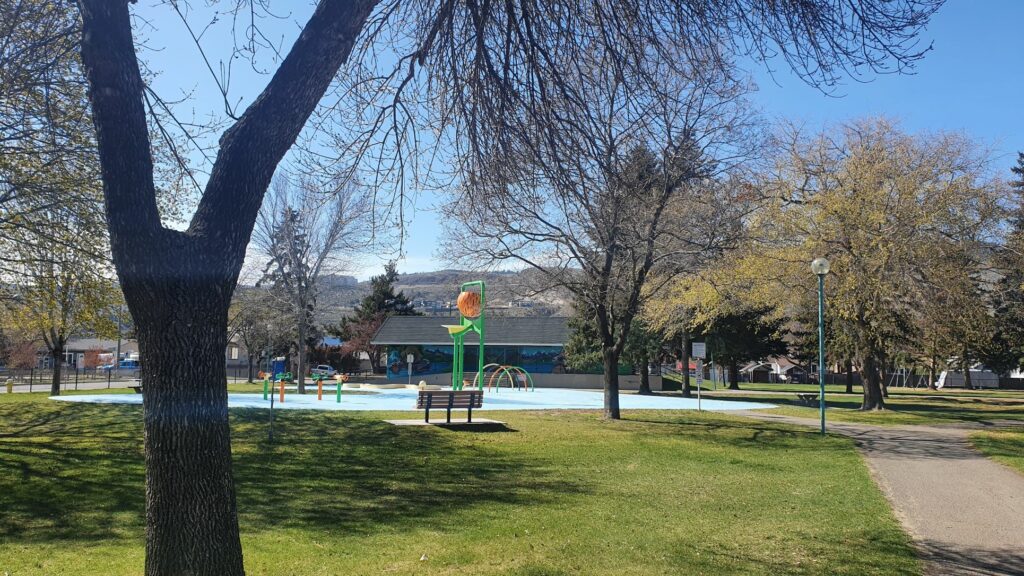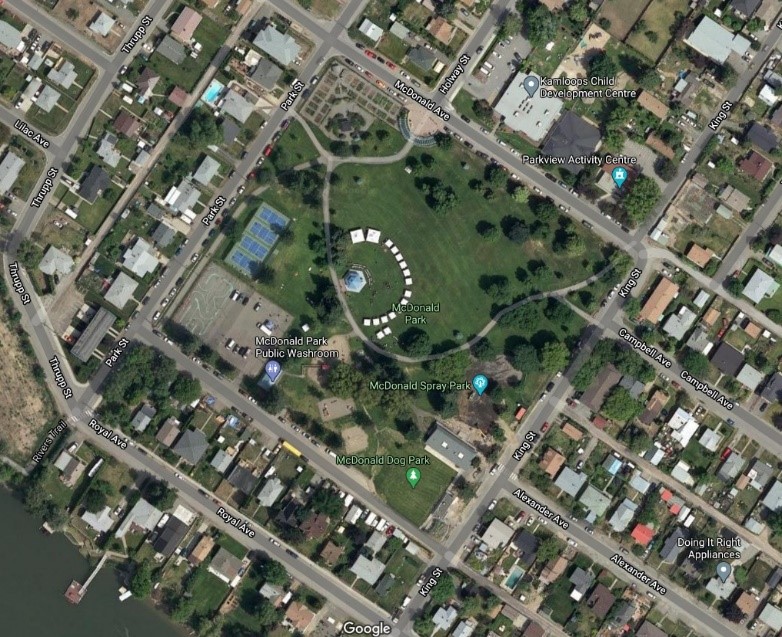4 McDonald Park
Taghiyev, Rashad
Introduction
Undeniably, urban parks provide lots of community benefits. Parks are green spaces in urban areas for the community to get out of their daily routine from gray to a more pleasant green space. Municipal parks are open access and are non-rival, provided there is no congestion, and thus yield collective benefits. They are provided and maintained by the local authorities who own the land. In this chapter, an assessment of the value of McDonald Park in Kamloops and the ecosystem services it provides will be examined, using the methodology described by Sutton and Anderson (2016) for the assessment of Central Park in NYC. Sutton and Anderson (2016) assumed that the real estate value of the area of Central Park was at least as much as its natural capital value. Applying an annual rate of return of 5% to the appraised real estate value of USD 528 billion, it arrived at USD 25 billion at the price of $73 million per hectare per year in ecosystem services mostly in the category of cultural and regulating. Assigning a dollar value to urban parks’ ecosystem services is a difficult but necessary task. It can help make economic and policy decisions, such as deciding between commercial development and public use, or the right amount of investment for urban parks maintenance and development.

McDonald Park
McDonald Park in Kamloops (Figure 1) is one of the oldest parks in the city’s North Shore area. It is a medium-sized urban park with an area of just under 3.05 ha. The park is packed with amenities and attractions, which serve the pretty dense community surrounding it. According to The City of Kamloops, the following are some of the park’s facilities. It boasts 3 open-air basketball courts and 3 open-air pickleball/tennis courts. Also, it has a multi-use pathway. There is a leashed dog park available inside the area. Throughout the summer a ‘Music in the Park’ entertainment is hosted in the park’s small bandshell. Kids can enjoy a water spray park during the warmer season. Public washrooms, 4 picnic tables, and a gazebo are present in the park too. Free public parking is also available for park visitors. Kamloops Child Development Centre, which is a non-profit that provides nature-based childcare for children from birth to 12 years of age is across the street from the park The 25th annual “Boogie the Bridge” running and walking event which is also a big fundraiser for Kamloops will have its start and finish in the park in 2022.

Method and Results
Here we start by following the same hedonic pricing methodology as Sutton and Anderson, (2016). Descriptive statistics of 36 properties adjacent to McDonald Park are presented in Table 1 (BC Assessment, 2022). The median land value for the properties adjacent to McDonald Park is CND 4.3 million per ha. This means that the total value of McDonald Park can be estimated as CND 13.1 million since the total area of the park is about 3.05 ha. The relatively high per hectare values reflect the density of the housing in the area. Applying a simple annual interest of 5% gives the per annum value of McDonald Park’s ecosystem services as CND 0.65 million. Alternatively, the ESVD database provided data gives per hectare per annum value for Urban Parks & Forests as CND 135,971 which equals CND 415,000 for the whole park. This number is equivalent to approximately 3.2% annual yield.
Table 1: McDonald Park Descriptive Statistics
| Variable | Mean | StDev. | Min. | Q1 | Med. | Q3 | Max. |
|---|---|---|---|---|---|---|---|
| Land value | 217,472 | 81,649 | – | 221,500 | 249,500 | 256,000 | 304,000 |
| Building value | 251,642 | 138,930 | 78,000 | 151,750 | 235,000 | 322,750 | 807,000 |
| Year built | 1962 | 23 | 1924 | 1950 | 1955 | 1965 | 2020 |
| Land size (ha) | 0.045 | 0.025 | – | 0.033 | 0.056 | 0.060 | 0.094 |
| Land value per ha | 3,692,937 | 2,010,375 | – | 3,595,661 | 4,292,147 | 4,467,019 | 7,474,931 |
Discussion and Conclusion
The CND 0.65 million per year of ecosystem services valuation of an asset worth 13.1 million CND is a quick and straightforward way to measure the value of the park to the city inhabitants, especially those who live close by and use the park’s multiple amenities frequently. The annual interest rate of 5% from Sutton and Anderson (2016) used here is at the top of the range of possible valuations. The ESVD assessment gives a yield of 3.2% which is similar to the social discount rate of 3.5% (Boardman et al, 2010). In my opinion, it is reasonable to value the McDonald park using at least a 3.2% yield or approximately CND 415,000 per annum. It is located in an area with dense housing and many people from the neighborhood visit the park for recreational purposes, to spend time with their children, or to walk their pets in the dog park. The nearby Child Development Center also uses the park for open-air activities with children. I believe that the value of the McDonald’s park to the neighborhood community is large enough to continue to keep it as a public green space.
References
BC Assessment – Independent, uniform and efficient property assessment. Bcassessment.ca. (2022). https://www.bcassessment.ca/.
Boardman, A., Moore, M., & Vining, A. (2010). The Social Discount Rate for Canada Based on Future Growth in Consumption. Canadian Public Policy. https://doi.org/10.3138/cpp.36.3.325
City of Kamloops, https://www.kamloops.ca/sites/default/files/docs/parks-recreation
Costanza, R., De Groot, R., Sutton, P., Van der Ploeg, S., Anderson, S. J., Kubiszewski, I., … & Turner, R. K. (2014). Changes in the global value of ecosystem services. Global environmental change, 26, 152-158.
Sutton, P. C., & Anderson, S. J. (2016). Holistic valuation of urban ecosystem services in New York City’s Central Park. Ecosystem Services, 19, 87-91.

